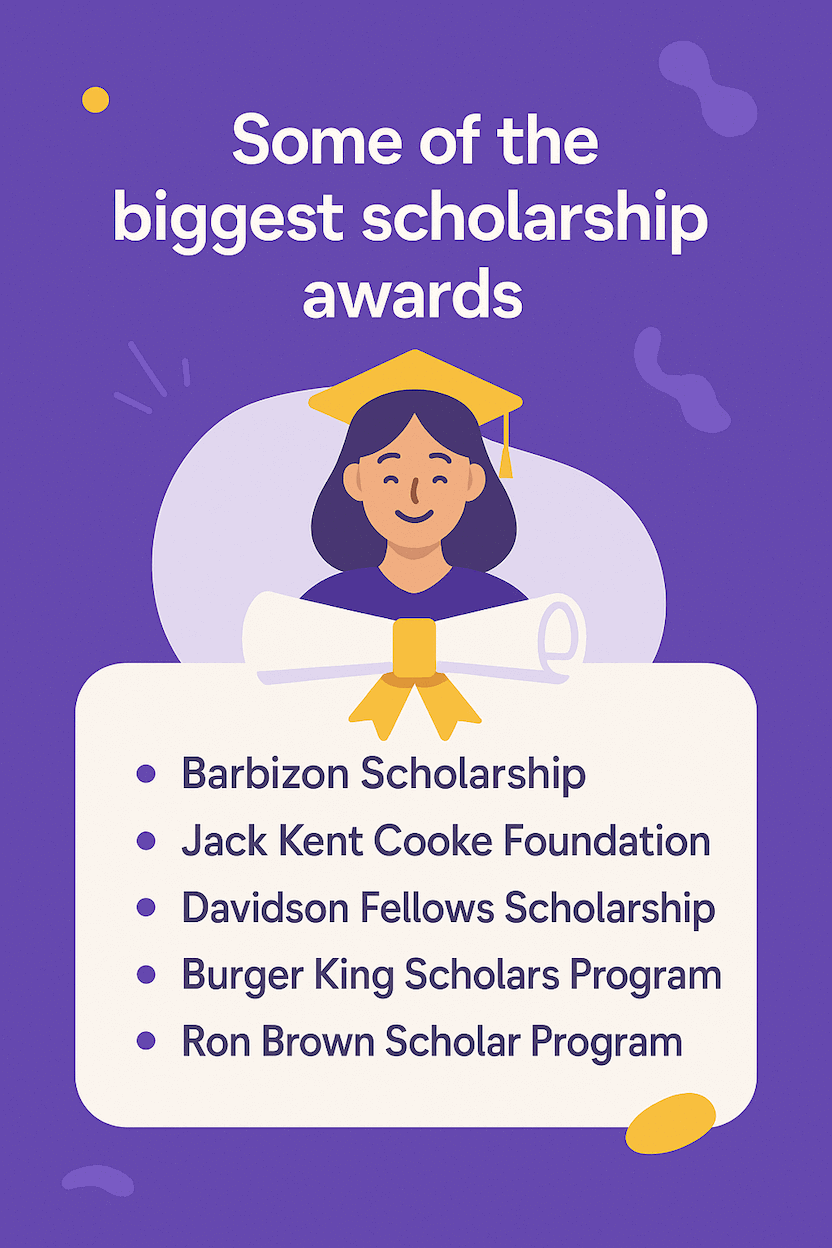Advertiser Disclosure
Last update: June 11, 2025
7 minutes read
How Many People Actually Win Scholarships? (The Statistics)
How many people get scholarships? Learn what percentage of students win awards, the impact of scholarship displacement, and which high-value scholarships to target.

By Brian Flaherty, B.A. Economics
Edited by Rachel Lauren, B.A. in Business and Political Economy
Learn more about our editorial standards



By Brian Flaherty, B.A. Economics
Edited by Rachel Lauren, B.A. in Business and Political Economy
Learn more about our editorial standards
Securing scholarship funding can feel like navigating a maze—there are millions of awards out there, but the path to actually receiving them isn’t always obvious.
In this post, we’ll cut through the noise by highlighting two critical areas: how accepting one award can affect the rest of your aid package, and the top high-value scholarships you should know about.
Armed with these insights, you’ll be better equipped to maximize the money you keep, not just the dollars you win.

Key takeaways
- Over 1.7 million scholarships are awarded each year, with 58% of U.S. families using them in some form
- Having good grades can boost your chances, but isn't the only criteria for scholarship eligibility
- STEM students tend to have a higher chance of receiving scholarships
How many people actually get scholarships?
Each year, more than 1.7 million scholarships are given to students. That's right, over a million chances to make college more affordable.
Even with these big numbers, only one in eight college students actually gets a scholarship. It might sound discouraging but don't lose hope. There could be 50 to 100 scholarships waiting for you if you know where to look.
When I was graduating high school, I wasn’t the student with the best grades or the most extracurricular activities. But I was still able to secure a few scholarships by knowing where to look and writing thoughtful applications. Let’s look at who actually gets scholarships in the U.S. - the answers might surprise you.
Who gets scholarships in the U.S.?
Students and their families often wonder: “Who actually gets these scholarships?” Believe it or not, it's not always about having the top grades.
While a great GPA can be helpful, it's not the only thing that matters when it comes to qualifying for scholarships. Take a look at these stats:
- 17% of students with a 3.5 to 4.0 GPA win private scholarships.
- 13.1% of students with a 3.0 to 3.4 GPA win private scholarships.
- 10.4% of students with a 2.5 to 2.9 GPA win a scholarship, so even they aren’t left out.
Do better grades secure more scholarships?
We're often told that having higher grades increases our chances of getting scholarships. While that’s true, don’t be discouraged if you’re not the best student.
Grades are important, but they're not the only factor. Even if your GPA isn't at the top, you still have a shot at winning a scholarship.
Are private scholarships any different?
If you're aiming for a private college scholarship, here's where things change a bit. Over 66% of students with above-average SAT and ACT scores receive private scholarships. So, for those private scholarships, keeping those grades up becomes more crucial.
What about STEM students vs non-STEM students?
Choosing to follow a path in STEM (Science, Technology, Engineering, Mathematics) could spring some scholarship opportunities your way. So, for those STEM enthusiasts out there, have a look at this fact:
- 17% of STEM students receive scholarships compared to 12.1% of non-STEM students

TuitionHero Tip
And here's another thing – more than 33% of all private scholarships in the U.S. go to these students. So, if you're diving into the STEM world, celebrate! Your chances of securing scholarship funding just got a boost.
How much is typically awarded in scholarships?
Now, let's talk numbers. How much can students expect to receive from these scholarships?
- Around 97% of students awarded scholarships received less than $2,500.
- Only a slim 0.2% of students receive scholarships worth $25,000 or more.
- The scarce full-ride scholarships (including both tuition and living expenses) are awarded to less than 0.1% of students.
How can you boost your chances for a scholarship?
To increase your chances of getting a scholarship, you should perform well in school, join clubs or sports, and write essays that fit the requirements of each scholarship. It can also help to submit letters of recommendation, show that you need financial help, and apply for many scholarships early.
You might already have the qualifications for 50 to 100 scholarships, you just might not know it yet. At TuitionHero, we help students and parents figure out the complicated parts of college financing, helping them find scholarship opportunities.
Compare private student loans now
TuitionHero simplifies your student loan decision, with multiple top loans side-by-side.
Compare Rates
Dos and don'ts of applying for scholarships
Knowing what to do and what not to do can greatly improve your chances of landing a scholarship. Some actions can boost your odds, while others might leave you in the dust. Here's a quick guide:
Do
Start your scholarship search early
Apply for as many scholarships as you're eligible for
Pay close attention to scholarship requirements
Spend time crafting a good application essay
Follow up on your application
Seek help from advisors and TuitionHero
Don't
Wait until the last minute to apply
Limit your applications to only a few scholarships
Apply for scholarships you don't qualify for
Submit a poorly written or rushed essay
Assume you've got the scholarship after submitting
Go about the scholarship search alone
What is scholarship displacement?
Many applicants don’t realize that private awards can actually reduce other aid. Scholarship displacement is when an external scholarship triggers a reduction in your institutional grant or other campus-based aid.
- 50% of students who receive private scholarships see their institutional grants cut back.
- 62% of schools reduce loan eligibility.
- 24% of schools reduce work-study or student-employment opportunities.
Here are some tips for managing scholarship displacement:
- Always check with your financial aid office before accepting a private scholarship.
- Ask whether external awards “stack” or if they’ll trigger automatic adjustments to your total aid package.
- Factor potential displacement into your decision—sometimes a smaller award that “stacks” is worth more in net dollars.

Top high-value scholarships to target
Beyond mass-market awards, these programs offer truly transformational funding:
Scholarship | Maximum award | Who it’s for |
|---|---|---|
Barbizon Scholarship | $100,000 | Talented performing arts and modeling students |
Jack Kent Cooke Foundation | $55,000/year | High-achieving high school seniors with financial need |
Davidson Fellows Scholarship | $50,000 | Extraordinary STEM, literature, or music projects |
Burger King Scholars Program | $50,000 | Community-minded student leaders |
Ron Brown Scholar Program | $40,000 | African-American students excelling in leadership and service |
Data table of scholarship statistics
Let’s dive into the details of scholarships. Here's an in-depth look at some data:
Scholarships Statistics | Value |
|---|---|
Percentage of U.S. families using scholarships | 58% |
Number of scholarships awarded annually | 1.7 million |
Percentage of students receiving state scholarships | 16% |
Percentage of students receiving private scholarships | 13% |
Percentage of scholarships awarded to STEM students | 33% |
Percentage of students awarded full-ride scholarships | 0.1% |
Advantages and disadvantages of applying for scholarships
Using scholarships as a strategy for college financing has its positives and negatives. Let's take a closer look at both:
- Ease the financial burden: Scholarships can reduce college costs by a lot.
- No requirement for repayment: Unlike loans, scholarships are free money. You won't have to worry about repaying anything.
- Can be available for all: Some scholarships don't focus on GPA, meaning all students have a shot.
- Highly competitive: With many students applying, securing a scholarship can be challenging.
- Time-consuming: The application process for scholarships can require a lot of time and resources.
- Limited funds: Most scholarships don't cover the entire cost of college. You might still need to explore other financial options.
Proposals to tax scholarships and eliminate tax-free status
House Republicans have floated a plan to treat all scholarships and fellowships as taxable income, repealing the IRC §117 exclusion that currently exempts tuition-related awards.
Under this proposal, even need-based and merit scholarships used for tuition, fees, and course materials would be taxed as ordinary income, potentially generating over $50 billion in federal revenue over ten years.
Graduate student awards—including university fellowships, teaching assistantships, and research assistant stipends—would also lose their tax-exempt status, exposing recipients to significant new tax liabilities.
Advocates warn that these changes could disproportionately burden low- and middle-income learners and reduce the net value of scholarship aid.

Why trust TuitionHero
At TuitionHero, we simplify the process of securing scholarships and navigating college finances. We assist with private student loans, refinancing, and FAFSA help. With millions of scholarships available, we're here to make your education more affordable. Let us handle the hard work while you focus on becoming a successful student.
Frequently asked questions (FAQ)
Scholarships are given out on a yearly basis in the U.S., with over 1.7 million scholarships awarded each year.
Not necessarily. While some scholarships prioritize academic accomplishment, many scholarships consider other factors like financial need, community service, leadership, and other talents.
Community service, leadership roles, and excelling in specific areas like arts or sports can increase your eligibility. Some scholarships also prioritize students pursuing courses in fields like Science, Technology, Engineering, and Mathematics (STEM).
Private scholarships usually consider academic performance in their criteria. Up to 66% of students with above-average SAT and ACT scores receive private scholarships. However, other factors might also be considered.
Among fields of study, health majors capture the largest share of federal grant and scholarship dollars, accounting for 18.4% of the total aid awarded by the Department of Education.
Full-ride scholarships are the most difficult to secure. Only about 0.1% of U.S. college students receive awards that cover full tuition and living expenses—a tiny fraction that underscores how competitive these “free ride” packages are.
Final thoughts
Navigating scholarships isn’t just about finding the largest awards—it’s about understanding how each piece fits into your overall financial aid puzzle and targeting the programs that deliver the biggest net benefit.
By keeping scholarship displacement top of mind and focusing on a handful of high-value opportunities, you’ll turn a confusing process into a strategic plan.
Now it’s your turn: check in with your aid office, add those deadlines to your calendar, and start crafting applications for the awards that matter most. Good luck!
Sources
Author

Brian Flaherty
Brian is a graduate of the University of Virginia where he earned a B.A. in Economics. After graduation, Brian spent four years working at a wealth management firm advising high-net-worth investors and institutions. During his time there, he passed the rigorous Series 65 exam and rose to a high-level strategy position.
Editor

Rachel Lauren
Rachel Lauren is the co-founder and COO of Debbie, a tech startup that offers an app to help people pay off their credit card debt for good through rewards and behavioral psychology. She was previously a venture capital investor at BDMI, as well as an equity research analyst at Credit Suisse.
At TuitionHero, we're not just passionate about our work - we take immense pride in it. Our dedicated team of writers diligently follows strict editorial standards, ensuring that every piece of content we publish is accurate, current, and highly valuable. We don't just strive for quality; we aim for excellence.
Related posts
While you're at it, here are some other college finance-related blog posts you might be interested in.
Shop and compare student financing options - 100% free!

Always free, always fast
TuitionHero is 100% free to use. Here, you can instantly view and compare multiple top lenders side-by-side.

Won’t affect credit score
Don’t worry – checking your rates with TuitionHero never impacts your credit score!

Safe and secure
We take your information's security seriously. We apply industry best practices to ensure your data is safe.
Finished scrolling? Start saving & find your private student loan rate today
Compare Personalized Rates




